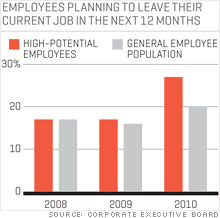September 26, 2011
Wouldn’t it be great if you could wave your magic wand and abracadabra, up go sales and profits? If you flunked advanced wizardry, don’t worry. Believe it or not, this is a trick for mere mortals. All you have to do is make your employees happy.
Happy workers perform
In a Gallup, Inc. study of over two thousand business units on “the causal impact of employee work perceptions on the bottom line of organizations,” researchers found a distinct link between employee attitudes and a company’s financial performance, employee retention and customer loyalty.
Research conducted by the Wharton School found that Fortune’s “100 Best Companies to Work For in America” reported 3.5 percent higher returns than their peers (Harvard Business Review Daily Stat).
Of course there’s the chicken and the egg question. Is company performance better because its employees are more engaged or is it the other way around? According to the Gallup study, the answer is clearly the former—happy employees are productive employees.
But most employees aren’t happy
Unfortunately, for the majority of businesses, employee engagement—a strong indicator of satisfaction and morale—is in the toilet.
According to a study by Mercer, a global HR consulting firm, nearly a third (32 percent) of U.S. workers are seriously considering looking for a new job (up from 23 percent in 2005). Another one in five (21 percent) don’t have plans to leave but also don’t give a rat’s buttocks about what they’re doing—just the kind of people you want on the payroll. (Mercer’s What’s Working survey)
Similarly, Blessing White, a global consulting firm that focuses on employee engagement, found that only a third of U.S. employees are fully engaged. Their research, and that of other industry experts, shows that the most engaged employees are both highly satisfied and high contributors to the organization.
In their 2011 Global Engagement Report, they summarize the level of engagement of North American employees as follows:
- Highly engaged: 33 percent of North American employees.
- Almost engaged: 10 percent—high performers and reasonably satisfied but not consistent.
- Honeymooners and hamsters: 24 percent—either new to the organization in a kind of limbo or “working hard but, in effect, spinning their wheels.
- Crash & Burners: 15 percent—“disillusioned and potentially exhausted.”
- Disengaged: 18 percent—not contributing very much and not very satisfied; likely skeptical and may spread their negativity around the organization.
Millennials were the least engaged (only 23 percent were highly engaged and 25 percent were disengaged). Boomers were the opposite (36 percent were highly engaged and 16 percent were disengaged).
Looking at the numbers by department or function, employees in sales showed the highest engagement (38 percent in Blessing White’s highest engagement category) and IT and R&D workers showed the lowest (26 percent). Worse, 27 percent in engineering and 22 percent in IT were categorized as disengaged. Think about that next time you walk into a smart building.
So how do you make your employees happy?
Read the full story:
http://www.openforum.com/articles/wanna-make-more-money-make-your-employees-happy?extlink=em-openf-SBdaily



